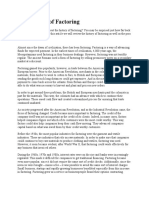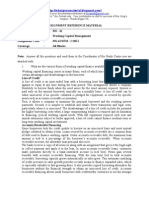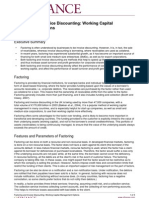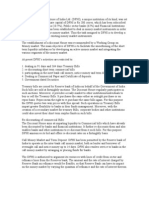What Is Factoring
What Is Factoring
Uploaded by
redsaluteCopyright:
Available Formats
What Is Factoring
What Is Factoring
Uploaded by
redsaluteOriginal Description:
Original Title
Copyright
Available Formats
Share this document
Did you find this document useful?
Is this content inappropriate?
Copyright:
Available Formats
What Is Factoring
What Is Factoring
Uploaded by
redsaluteCopyright:
Available Formats
What is Factoring?
Factoring is a service involving the purchase by a financial organization, called a factor, of receivables owed to manufacturers and distributors by their customers, with the factor assuming full credit and collection responsibilities. Those organizations that restrict their activities to extending advance payments to clients when goods are shipped are called old-line factors. Commercial finance companies and commercial banks also provide various factoring services as well as other methods of financing their clients. Factoring should be distinguished from accounts receivable financing, in which a business firm retains its accounts receivable and obtains a loan secured by a pledge of those receivables.
Functions
A factor may perform two main functions for a business firm. In all cases he first acquires the accounts receivable generated by sales to customers whose credit standing he has checked and approved. The first function, called maturity factoring, involves only the service benefits of factoring. In this function, the factor collects required payments directly from the customers, handles the necessary bookkeeping, and absorbs any bad-debt losses that may occur. For these services the factor charges the business firm selling its receivables a fee ranging from 0.75 to 2% of credit sales. The percentage depends upon the dollar volume, terms of trade, the number of transactions, and the risk of incurring bad-debt losses. Companies using only this function of the factor receive payment for their receivables shortiy after the average maturity date of each month's sales invoices. Even if a customer is late in paying the factor, the firm selling its receivables is paid by the factor at the agreed time. A second function that may be performed by factors is to advance cash to the firm selling its receivables immediately upon shipment of the goods. This means that the firm selling its receivables does not need to wait, say 30 to 60 days, to receive cash for its receivables, as in the case of maturity factoring. The amount of the cash advance is usually about 90% of the invoice price. Since the factor is advancing money before he has collected funds from the receivables, he charges for this loan for the period of time from the date of the advance to the average invoice maturity date. Interest rates are usually a few points above, but tied to, the prime lending rate of New York banks. However, factors charge interest on daily balances and do not require the maintenance with them of minimum cash balances, as do most commercial banks.
Origins
Factoring is an ancient function. The Babylonian Code of Hammurabi covered certain trade practices of merchants' agents who guaranteed trade credits. The rapid growth of international trade from the Middle Ages through American colonial times went hand-in-hand with a growth in factoring. The role of factors in this era is illustrated by the "cotton-factors" in the United States in the early 19th century. Mills in England entrusted their products to these factors. Although they did not take title to the goods, the factors provided storage facilities, sold and delivered the merchandise, guaranteed the credits extended to buyers, and advanced funds to the mills against the receivables and consigned inventories. The initial concentration of these textile factors in New York has made it the factoring center of the nation.
As textile manufacturers became established in the United States, they no longer required the factor to handle storage, selling, and delivery. Consequently, these roles were gradually peeled away from the factor, leaving him with the functions of assuming credit and collection responsibilities as well as providing advances against purchased receivables.
Industry Structure
Factors later expanded far beyond the textile field and began to provide many other financial services. As a result the old-line factor diminished in relative importance. An important change has been the entry of commercial banks into the field. Although the First National Bank of Boston has provided factoring to its clients for many years, the modern rush into factoring began in 1965 with the purchase of Hubshman Factors by the First National City Bank, New York. Now large banks often have factoring departments. Although the entry of commercial banks into factoring has made the field more competitive, it has also expanded the market for factoring to even more product lines. In earlier years some firms were loathe to factor their receivables because they feared that customers would doubt their financial strength. This hesitation has largely disappeared as more and more firms have come to accept factoring as simply another method of financing.
Economic Contribution
Factoring provides important economic benefits to business firms selling their receivables. The basic contribution might be termed "knowledgeable diversification of risk." The variety of receivables held by a factor provides greater diversification than is available to a firm in one line of business. Additionally, breadth of experience gives the factor an expertise in management of accounts receivable. These advantages are particularly apparent in export financing. Coupled with some economies of large-scale operation, these benefits permit a factor to perform the credit and collection functions at a lower cost than many of its clients could achieve. Factoring may be especially suitable for a firm with a highly seasonal business, since it would be uneconomical for it to support a credit department during slack periods. Factors also provide financing that may not be available from other sources for small and rapidly expanding business firms. As sales expand, so do the immediately available funds from the factor. Once the firm has been able to build an adequate base of retained earnings, it may "graduate" to a less expensive, unsecured line of credit at a commercial bank. However, many companies continue to factor their receivables to obtain the credit services provided and to offer credit more freely than if forced to rely on their own expertise and resources. Factoring firms offer a number of ancillary services to clients. Their knowledge of the market makes them helpful in planning budgets and sales projects. Some provide computer services that generate salesmen's commission reports, product or style analyses, or other kinds of information. As the proportion of accounts receivable to sales of manufacturers continues to expand, and as the variety of firms seeking factoring widens, it appears that factoring will continue to be an important means of financing economic growth.
You might also like
- Alternate Source of Finance, Private and Social Cost-Benefit, Public Private PartnershipDocument20 pagesAlternate Source of Finance, Private and Social Cost-Benefit, Public Private PartnershipRewant MehraNo ratings yet
- Factorin BillDocument24 pagesFactorin BillShruti PatilNo ratings yet
- Factoring Project ReportDocument15 pagesFactoring Project ReportSiddharth Desai100% (3)
- Banking Chapter FiveDocument44 pagesBanking Chapter FivefikremariamNo ratings yet
- Do Banks Need To Advertise?Document19 pagesDo Banks Need To Advertise?Rahul GargNo ratings yet
- IInd Unit - Factoring and Venture CapitalDocument28 pagesIInd Unit - Factoring and Venture Capitalguna57617No ratings yet
- Factoring AssignmentDocument24 pagesFactoring Assignment220060201025.ishanNo ratings yet
- The Conceptual Framework of Factoring On Small and Medium EnterprisesDocument6 pagesThe Conceptual Framework of Factoring On Small and Medium EnterprisesSavyasaachi ManjrekarNo ratings yet
- FactoringDocument16 pagesFactoringhiteshjoshi01No ratings yet
- PresentatonDocument5 pagesPresentatonRajesh MongerNo ratings yet
- Week 03 - Module 03 - Banking Industry and Nonbanking Financial InstitutionsDocument24 pagesWeek 03 - Module 03 - Banking Industry and Nonbanking Financial Institutions지마리No ratings yet
- Factoring in IndiaDocument16 pagesFactoring in IndiadaveferalNo ratings yet
- FACTORINGDocument6 pagesFACTORINGsadathnooriNo ratings yet
- Leveraged Buy-Out (LBO)Document2 pagesLeveraged Buy-Out (LBO)Kent WhiteNo ratings yet
- Commercial Lendings by BanksDocument65 pagesCommercial Lendings by Banksvivek satviNo ratings yet
- Short-Term Liability ManagementDocument11 pagesShort-Term Liability ManagementScribdTranslationsNo ratings yet
- Sources of FundsDocument10 pagesSources of Fundsluciferofhell1969No ratings yet
- Equity Financing Small Business AdministrationDocument8 pagesEquity Financing Small Business AdministrationrajuNo ratings yet
- FactoringDocument23 pagesFactoringDeepak KanojiaNo ratings yet
- Factoring: Accounts ReceivableDocument3 pagesFactoring: Accounts ReceivableRia BhardwajNo ratings yet
- Basics of Lending, Its Products AndfeaturesDocument62 pagesBasics of Lending, Its Products AndfeaturesANAM RAUF (GCUF)100% (1)
- Factoring: BY: NOU Shin ESA BA REB ECC ADocument20 pagesFactoring: BY: NOU Shin ESA BA REB ECC AnoushinesabaNo ratings yet
- Ms 41Document12 pagesMs 41kvrajan6No ratings yet
- Limitations of FactoringDocument12 pagesLimitations of Factoringkomalthorat50% (2)
- A Comparative Study On Factoring Services in IndiaDocument55 pagesA Comparative Study On Factoring Services in IndiaChinmay VangeNo ratings yet
- Fim Cha2Document9 pagesFim Cha2newaybeyene5No ratings yet
- Unit 1 Finacial CreditDocument21 pagesUnit 1 Finacial Creditsaurabh thakurNo ratings yet
- Project Report ON: FactoringDocument22 pagesProject Report ON: Factoringabcdefghi_123456789No ratings yet
- Activity of Credit Intermediation and Factoring Companies in PolandDocument5 pagesActivity of Credit Intermediation and Factoring Companies in PolandjournalNo ratings yet
- What Is Factoring? An Introductory Guide - ICC AcademyDocument11 pagesWhat Is Factoring? An Introductory Guide - ICC AcademyheroadolfNo ratings yet
- FIN-09Document26 pagesFIN-09simarjeetkaurmehra546No ratings yet
- Factoring and Invoice Discounting Working Capital Management OptionsDocument5 pagesFactoring and Invoice Discounting Working Capital Management OptionsKomal ParikhNo ratings yet
- Debtors Financing-Factoring: Swayam Siddhi College of MGMT & ResearchDocument15 pagesDebtors Financing-Factoring: Swayam Siddhi College of MGMT & Researchpranjali shindeNo ratings yet
- Evaluating Credit WorthinessDocument4 pagesEvaluating Credit WorthinessHazyan HamdanNo ratings yet
- What Is A Financial InstituteDocument7 pagesWhat Is A Financial InstituteRahim RazaNo ratings yet
- Receivable Management: 1.1. Introduction To The StudyDocument21 pagesReceivable Management: 1.1. Introduction To The StudyMythili Karthikeyan100% (1)
- Written Mancon KEVIN CHUADocument4 pagesWritten Mancon KEVIN CHUAIsaiah CruzNo ratings yet
- Corporate Bonds Vs Bank LoansDocument7 pagesCorporate Bonds Vs Bank LoansYssa MallenNo ratings yet
- A Case StudyDocument10 pagesA Case StudyAvila SimonNo ratings yet
- Working Capital Loan: LoansDocument5 pagesWorking Capital Loan: LoansNiharika SharmaNo ratings yet
- What Does Credit Crisis Mean?Document14 pagesWhat Does Credit Crisis Mean?amardeeprocksNo ratings yet
- Famd Assingnment: The Sources of FinanceDocument11 pagesFamd Assingnment: The Sources of FinanceCoulibaly YounoussouNo ratings yet
- Factoring FSDocument13 pagesFactoring FSAvinaw KumarNo ratings yet
- Accounts Receivable ManagementDocument7 pagesAccounts Receivable Managementsubbu2raj3372No ratings yet
- Canilang, Julius Ceasar Duarte, Mary Lyn Flores, John Robin: Name: Betiola, Rachelle AnnDocument8 pagesCanilang, Julius Ceasar Duarte, Mary Lyn Flores, John Robin: Name: Betiola, Rachelle AnnMary Lyn DuarteNo ratings yet
- Automate Every Part of Commercial Lending ProcessDocument20 pagesAutomate Every Part of Commercial Lending Processarul.btugNo ratings yet
- Factoring (Financial Services)Document36 pagesFactoring (Financial Services)Niket DattaniNo ratings yet
- Capital Unit Test MidtermDocument3 pagesCapital Unit Test MidtermJessa Dela Cruz SahagunNo ratings yet
- Project Report On FactoringDocument65 pagesProject Report On FactoringNIKHIL SHRIVASTAVA50% (2)
- Myths On FactoringDocument2 pagesMyths On FactoringNitish PandeyNo ratings yet
- Factoring Services: Submitted by Arulselvam.R 08-CO-455Document25 pagesFactoring Services: Submitted by Arulselvam.R 08-CO-455Arul SelvamNo ratings yet
- Peer 4 Section CDocument12 pagesPeer 4 Section CRibka FisshaNo ratings yet
- Chapter 2Document8 pagesChapter 2Pradeep RajNo ratings yet
- Theoritical FrameworkDocument4 pagesTheoritical FrameworkMd Tarek Rahman0% (1)
- Loan EquirementDocument3 pagesLoan Equirementrigsdriller94No ratings yet
- Origin of The Word: Secured LoansDocument4 pagesOrigin of The Word: Secured LoansMahesh TejaniNo ratings yet
- Unlocking Financial Opportunities: A Comprehensive Guide on How to Establish Business CreditFrom EverandUnlocking Financial Opportunities: A Comprehensive Guide on How to Establish Business CreditNo ratings yet
- Unlocking Capital: A Business Owner's Handbook to Small Business FinancingFrom EverandUnlocking Capital: A Business Owner's Handbook to Small Business FinancingNo ratings yet
- Elliott Wave TheoryDocument2 pagesElliott Wave TheoryredsaluteNo ratings yet
- Legal Aspects of LeasingDocument1 pageLegal Aspects of LeasingredsaluteNo ratings yet
- What Is National Income?: AnswerDocument7 pagesWhat Is National Income?: AnswerredsaluteNo ratings yet
- InflationDocument22 pagesInflationredsaluteNo ratings yet
- Inflation and DeflationDocument10 pagesInflation and Deflationredsalute100% (1)
- InflationDocument22 pagesInflationredsaluteNo ratings yet
- 733 Industrial RelationsDocument261 pages733 Industrial Relationsrao253No ratings yet
- Money Market in IndiaDocument17 pagesMoney Market in IndiaredsaluteNo ratings yet
- Business CyclesDocument4 pagesBusiness CyclesredsaluteNo ratings yet
- Financial Guarantee ProjectDocument3 pagesFinancial Guarantee ProjectredsaluteNo ratings yet
- What Is FactoringDocument2 pagesWhat Is FactoringredsaluteNo ratings yet
- Discount and Finance House of India LTDDocument2 pagesDiscount and Finance House of India LTDGaurav BaingNo ratings yet
- 634735338799306250Document22 pages634735338799306250regan165No ratings yet
- Money MarketDocument6 pagesMoney MarketredsaluteNo ratings yet
- RJSH PROJDocument1 pageRJSH PROJredsaluteNo ratings yet









































































